"Grilled in Germany" or
"Poached in Phillipsburg"!
Re-enactment
by Steve Vickers, Alfred Umhey. Illustrations by Teri Julians
| |
At right, Grenadier of Line Infantry.
At right, French foot artillery prepare to bombard the allied position which stands on the ground just in front where the original town once stood.
At right, Cannonier artillerie a pied.
A small force of French attacked the town using four 12pounder cannon and four Mortars with a supporting force of infantry. The ordnance pounded the town inside the walls constantly for two and a half days. With no effective defence against this onslaught the Austrians had no other option than to surrender. Although the walls of the town were intact the town within had been practically destroyed.
Phillipsburg is a small town and the walls have long disappeared. Indeed following the treaty of Luneville in 1801 it was agreed to destroy the wall and thus take away the military and strategic importance of the town. All that is left from the historic encounter is the earthworks leading to where the town's walls used to be. This is where the commemoration was to take place.
At right, Austrian artillery measures up the range to the coolling towers. The nuclear power station stands where the French artillery may have been 200 years ago.
As a true re-creation of a small but important encounter we were able to field 4 pieces of French ordnance. The effect of having 50% of the actual number of canon gave us a good idea of the destructive influence these "bouche a feu" had at the time.
The Artillery deployed at the centre of the field with a supporting force of Infantry on the right flank and the light cavalry on the left.
Outgunned and out manoeuvred the Saxon Brigade withdrew in good order to the fruit orchard only to be met by the Hussar de Batave (at right) who were able to force the Saxons back in front of the French Artillery and Infantry. The Saxon infantry made a vain attempt to recover their bivouac but it had already been plundered by the Demi-brigades. The outflanking manoeuvre cut off any escape the Saxons may have attempted and in front of such a force had no option but to surrender. Originally taking two and a half days we reduced the encounter to 1 hour.
At right, Cannonier of the 3e regimenyt d'artillerie legere (Artillerie a cheval).
In the age old tradition our participants took part in the street party that followed which finished off what was a very warm, friendly and historic weekend. No doubt in another 100 years our successors will have the urge to re-create this interesting "skirmish". In the meantime the Corps d'Artillerie move onto other bicentennials and re-enactments whereever General Bonaparte commands us to go.
Commandant d'Armée – Capitain Etienne Petranella
Commandant d'Infanterie – Caporal Joli Beaujolais
Commandant du Cavalerie – Lieutenant Christian Colmont
Army Commander – Feldwebel Tobias Reh
Light Infantry Commander – Patrouillenfuehrer Konrad Koechler
Artillery Commander – Horst Schmittner
For more information on the Corps d'Artillerie or ENS please contact: Steve Vickers, 12 Winton Way, Dymchurch, Romney Marsh, Kent, TN29 0QH. Tel: 07971 566005
|
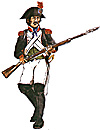 Across the channel and off to Germany, the Corps d'Artillerie and other European Napoleonic Society members set off to tackle another bicentennial. This time the event commemorates a particular encounter that really only consisted of French Artillery and buildings!
Across the channel and off to Germany, the Corps d'Artillerie and other European Napoleonic Society members set off to tackle another bicentennial. This time the event commemorates a particular encounter that really only consisted of French Artillery and buildings!
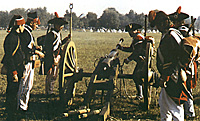 The town of Phillipsburg lays 20km North of Karlsruhe in the South West Palatinate in Germany and 2km from the Rhine.
In September of 1799 an Austrian force of around 3000 infantry held Phillipsburg. It had been an arena for sieges before and had a high wall all round to aid its defence against any onslaught. However this time the defenders appeared to lack any artillery.
The town of Phillipsburg lays 20km North of Karlsruhe in the South West Palatinate in Germany and 2km from the Rhine.
In September of 1799 an Austrian force of around 3000 infantry held Phillipsburg. It had been an arena for sieges before and had a high wall all round to aid its defence against any onslaught. However this time the defenders appeared to lack any artillery.
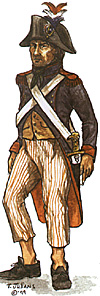 Being only 2km from the Rhine valley, Phillipsburg was considered of particular strategic importance and of course whoever holds the Rhine holds the key to trade and lines of communication to most of Central Europe. The scene is thus set for the Republican French forces to deal with this problem.
Being only 2km from the Rhine valley, Phillipsburg was considered of particular strategic importance and of course whoever holds the Rhine holds the key to trade and lines of communication to most of Central Europe. The scene is thus set for the Republican French forces to deal with this problem.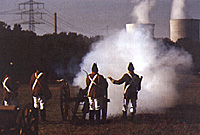 In a large meadow surrounded by trees with a fruit tree orchard on one side and the cooling towers of a Nuclear Power Station on the other we set up the combined forces bivouac alongside the road which was to be the only place where there wasn't any shade from the sun.
In a large meadow surrounded by trees with a fruit tree orchard on one side and the cooling towers of a Nuclear Power Station on the other we set up the combined forces bivouac alongside the road which was to be the only place where there wasn't any shade from the sun.
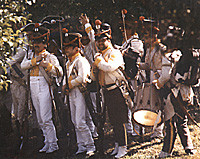
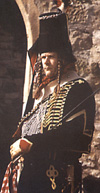 As an opposing force we encountered the Saxon Brigade (at left) and a contingent of Austrian Jäger. The defenders were outnumbered but more importantly outgunned. The only piece of ordnance to support the Saxon Brigade being an Austrian 3 pounder that was rushed from Wurtzburg to aid the cause.
As an opposing force we encountered the Saxon Brigade (at left) and a contingent of Austrian Jäger. The defenders were outnumbered but more importantly outgunned. The only piece of ordnance to support the Saxon Brigade being an Austrian 3 pounder that was rushed from Wurtzburg to aid the cause.
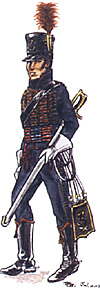 Unfortunately for the Saxons it was not going to end there. Later that day the Infantry of all sides took part in a play held by the residents of Phillipsburg and a distant French gun fired a salute to finalise the military part of the event and put this encounter back in the history books.
Unfortunately for the Saxons it was not going to end there. Later that day the Infantry of all sides took part in a play held by the residents of Phillipsburg and a distant French gun fired a salute to finalise the military part of the event and put this encounter back in the history books.